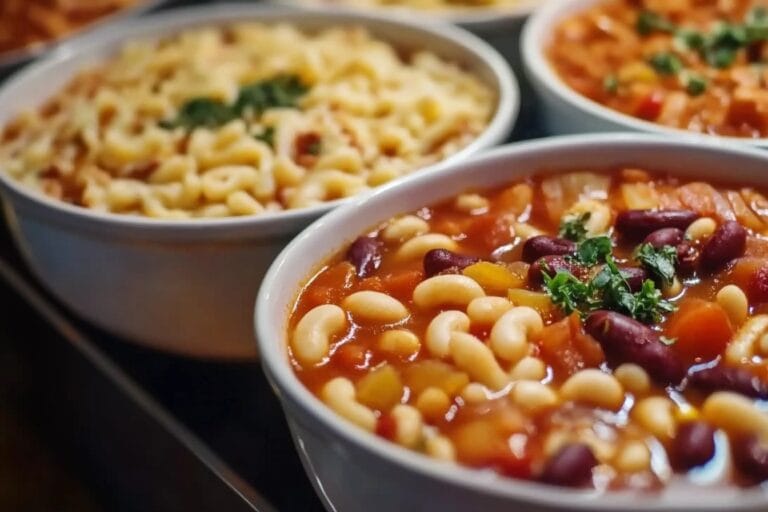If you’ve ever heard of Pasta Fagioli or Pasta Fazool, you may be wondering what the difference is between the two. These names both refer to a hearty, bean-based Italian dish, but the terminology changes based on region and cultural influences. While both dishes share common roots, they have subtle differences in how they’re prepared and enjoyed.
In this article, we’ll dive into the key distinctions between Pasta Fagioli and Pasta Fazool, exploring how these terms evolved and why they’re still used today. We’ll also uncover how this dish found its place in Italian-American cuisine.
The Origins of Pasta Fagioli
Pasta Fagioli, which literally translates to “pasta and beans,” has its origins in Italy. It was once considered a peasant dish because it relied on inexpensive, easily accessible ingredients like beans and pasta. The dish was highly adaptable and spread across Italy, with each region adding its own touch. Some versions are more broth-based, while others lean heavily on tomatoes.
In the U.S., when Italian immigrants brought Pasta Fagioli with them, the dish evolved into what many know as Pasta Fazool. The term “fazool” comes from the Neapolitan word for beans, fasule, reflecting the dialect spoken by many immigrants who arrived in America from southern Italy.
For a sweet treat to pair with this dish, you might want to try these Earl Grey Cookies, which add a delicate flavor to balance out the hearty soup.
What is Pasta Fagioli?
At its core, Pasta Fagioli is a simple and nutritious dish made from:
- Beans: Cannellini or kidney beans are commonly used.
- Pasta: Ditalini or another small pasta variety.
- Vegetables: Onions, carrots, and celery provide flavor and texture.
- Tomato or Broth Base: Some versions use a tomato base, while others rely on a light broth.
- Herbs and Seasonings: Oregano, basil, and thyme are typical flavorings.
The flexibility of the dish means that it can be adapted to personal taste. For example, some families add pancetta or sausage, while others keep it vegetarian.
For another comforting and versatile recipe, you might enjoy a Pumpkin Banana Loaf, a great option for dessert after a warm bowl of soup.
What is Pasta Fazool?
Pasta Fazool is the Americanized version of Pasta Fagioli. The name reflects the Neapolitan dialect, but the dish itself is largely the same. However, Pasta Fazool in the U.S. often takes on a thicker, stew-like quality and frequently includes ground beef or sausage, appealing to American tastes. This heavier, heartier adaptation became a staple in Italian-American households, especially in areas with large immigrant populations.
Common Ingredients of Pasta Fazool:
- Beans: Kidney beans or cannellini beans.
- Meat: Ground beef or sausage is a common addition in the American version.
- Tomato-Based Stew: A rich, tomato-heavy broth that gives the dish its stew-like consistency.
- Spices: Red pepper flakes are sometimes added for extra heat.
The American adaptation is typically richer and meatier, contrasting with the lighter, broth-based Italian versions. If you’re interested in trying more Italian-American adaptations, check out how to make delicious and easy on-the-go pancake muffins for a quick breakfast alongside your meal.
Key Differences Between Pasta Fagioli and Pasta Fazool
1. Pronunciation and Language
- Pasta Fagioli: The traditional Italian name, pronounced “fah-joh-lee”.
- Pasta Fazool: The Americanized name, pronounced “fa-zool”, derived from the Neapolitan dialect.
2. Regional Variations
- Pasta Fagioli: Can be either a soup or stew, depending on the region in Italy.
- Pasta Fazool: Often a thicker stew in the U.S., with a heavier focus on tomatoes and meat.
3. Meat Inclusion
- Pasta Fagioli: Meat is optional, and the dish is often vegetarian or made with small amounts of pancetta.
- Pasta Fazool: American versions commonly include ground beef or Italian sausage to create a heartier meal.
4. Broth vs. Tomato Base
- Pasta Fagioli: Often made with a light broth or a thin tomato base.
- Pasta Fazool: Heavier on tomatoes, creating a thick, rich stew.
Nutritional Comparison
Both Pasta Fagioli and Pasta Fazool are nutritious, filling meals with significant health benefits:
- High in Fiber: Beans contribute a high fiber content, which supports digestion.
- Low in Fat: If prepared without meat, both dishes are naturally low in fat and perfect for a heart-healthy diet.
- Protein-Packed: Beans provide a great source of plant-based protein, making the dish suitable for vegetarians.
To make a healthier version of either dish, you can reduce the amount of pasta or switch to whole-grain pasta. If you’re seeking more healthy meal options, check out this post on what is the easiest healthiest meal for more inspiration.
FAQs
What does Pasta Fazool mean?
Pasta Fazool is the Americanized version of Pasta Fagioli, based on the Neapolitan dialect, where “fazool” means beans.
Are Pasta Fagioli and Pasta Fazool the same dish?
Yes, they are essentially the same dish, but the name differs due to dialect and American adaptations. Pasta Fazool is often thicker and meatier, reflecting the preferences of Italian-American communities.
Can Pasta Fagioli be made vegetarian?
Absolutely! You can omit the meat and use vegetable broth. The beans provide plenty of protein, making it a hearty, satisfying meal.
How is Pasta Fagioli traditionally served?
In Italy, it’s commonly served as a soup or stew, depending on the region. It’s often enjoyed with crusty bread and grated Parmesan.
Conclusion
Whether you call it Pasta Fagioli or Pasta Fazool, this dish remains a beloved classic in both Italy and Italian-American cuisine. The main difference comes down to pronunciation and a few regional tweaks, but both versions offer a warm, comforting meal that’s easy to make and endlessly adaptable. So why not try both versions and see which one you prefer?
Print
What is the difference between pasta fagioli and pasta fazool?
If you’ve ever heard of Pasta Fagioli or Pasta Fazool, you may be wondering what the difference is between the two. These names both refer to a hearty, bean-based Italian dish, but the terminology changes based on region and cultural influences. While both dishes share common roots, they have subtle differences in how they’re prepared and enjoyed.
- Total Time: 40 minutes
- Yield: 6 servings 1x
Ingredients
- 2 tablespoons olive oil
- 1 medium onion, diced
- 2 celery stalks, diced
- 2 carrots, diced
- 3 cloves garlic, minced
- 1 can (15 oz) cannellini beans, drained and rinsed
- 1 can (15 oz) kidney beans, drained and rinsed
- 1 can (15 oz) diced tomatoes
- 4 cups chicken or vegetable broth
- 1 cup ditalini pasta
- 1 teaspoon dried oregano
- 1 teaspoon dried basil
- 1/2 teaspoon red pepper flakes (optional)
- Salt and pepper to taste
- Grated Parmesan cheese (optional for serving)
Instructions
- Sauté Vegetables: Heat olive oil in a large pot over medium heat. Add diced onion, celery, and carrots, and sauté for 5-7 minutes until softened. Add minced garlic and cook for another minute.
- Add Tomatoes and Broth: Stir in the diced tomatoes, chicken or vegetable broth, oregano, basil, and red pepper flakes. Bring to a simmer and cook for 15-20 minutes.
- Cook Pasta Separately: In a separate pot, cook ditalini pasta according to package instructions. Drain and set aside.
- Add Beans and Pasta: Stir in the drained beans and cooked pasta. Simmer for an additional 5 minutes, seasoning with salt and pepper to taste.
- Serve: Ladle into bowls and top with grated Parmesan cheese if desired.
Notes
Whether you call it Pasta Fagioli or Pasta Fazool, this dish remains a beloved classic in both Italy and Italian-American cuisine. The main difference comes down to pronunciation and a few regional tweaks, but both versions offer a warm, comforting meal that’s easy to make and endlessly adaptable. So why not try both versions and see which one you prefer?
- Prep Time: 10 minutes
- Cook Time: 30 minutes
- Category: soup
- Method: Stovetop
- Cuisine: Italian
- Diet: Vegetarian
Keywords: Pasta Fagioli, Pasta Fazool, pasta and beans, Italian soup, Italian-American cuisine, hearty soup, traditional Italian recipes, comfort food, vegetarian soup





